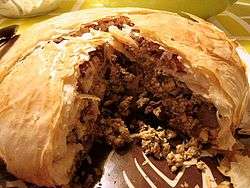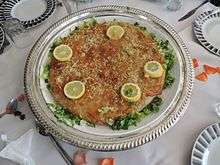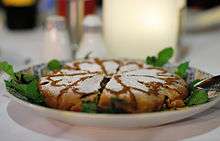Pastilla
 | |
| Type | Meat pie |
|---|---|
| Place of origin | Andalusia |
| Region or state | Morocco |
| Main ingredients | Warka dough, broth, spices; squab, chicken, fish or offal |
Pastilla (Moroccan Arabic: بسطيلة, translit. bəsṭila) is a traditional Moroccan dish consumed in countries of the Maghreb. It has also spread recently to Algeria and Tunisia.[1] Pastilla is said to be "uniquely Moroccan, intricate and grand, fabulously rich and fantastical".[2]
Origin

The name of the pie comes from the Spanish word 'pastilla', meaning in modern Spanish either pill or "small pastry" after the transformation of the phoneme "p" into "b" that is specific to the Arabic language.[3] It is an elaborate meat pie traditionally made of squab (fledgling pigeons). As squabs are often hard to get, shredded chicken is more often used today; pastilla can also use fish or offal as a filling.[4] Pastilla is generally served as a starter at the beginning of special meals.[5]
Classic savoury pastilla
It is a pie which combines sweet and salty flavours; a combination of crisp layers of the crêpe-like werqa dough (a thinner cousin of phyllo dough), savory meat slow-cooked in broth and spices and then shredded, and a crunchy layer of toasted and ground almonds, cinnamon, and sugar.[6]
The filling is made a day ahead, and is made by browning the meat pieces in oil. The pieces are then transferred to a bowl, and with the remaining oil, onions, water, parsley, and various spices are cooked. The liquid is then chilled, and after, thickened to form a custard-like sauce with beaten eggs. The flesh and skin from the bones is shredded and added to the sauce, and it is chilled overnight.
In a round pizza pan, the first dough layer is added, and butter brushed onto it. The cook adds the sauce over the dough, and places two more sheets on top. It is then baked, sprinked with confectioner's sugar and perhaps more cinnamon, and served.[7]
Pastilla with milk

In the traditional fassi cuisine, pastilla can also be served as a dessert, in which case, the pastilla is called Jowhara or Pastilla with milk. The pastilla is also made of warka and a milky cream put between the sheets. The Johara can also be flavored with orange flower water
See also
References
| Wikimedia Commons has media related to Pastilla. |
- ↑ "Migrations" (PDF). www.hommes-et-migrations.fr.
- ↑ E.P. Lenderking. Tanjia Marrakchia: Culinary Adventure at Dar Les Cigogues. 2013.
- ↑ Bastilla. Clifford A Wright. 2016
- ↑ Don Philpott (20 October 2016). The World of Wine and Food: A Guide to Varieties, Tastes, History, and Pairings. Rowman & Littlefield Publishers. p. 278. ISBN 978-1-4422-6804-3.
- ↑ Fodor's Travel Publications, Inc (2012). Fodor's Morocco. Fodors Travel Publications. pp. 19–. ISBN 978-0-307-92832-0.
- ↑ "Pastilla Recipe - Bastilla Recipe - Delicious Techniques". norecipes.com.
- ↑ "Pastilla Moroccan pigeon pie".
- ↑ "Did You Know: Food History - Bastila: a Culinary History of Morocco". www.cliffordawright.com. Retrieved 2017-05-25.